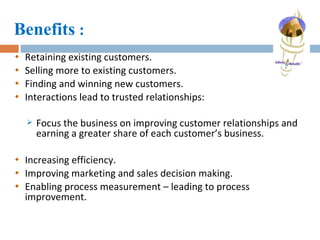E Crm
- 1. E-CRM Prepared By : Anshu Prabhakar (09mb41)
- 2. Customer Relationship Management (CRM) CRM is a strategy by which companies optimise profitability through enhanced customer satisfaction. CRM is about automating and enhancing the customer-centric business processes of Sales, Marketing, and Service. CRM not only deals with automating these processes, but also focuses on ensuring that the front-office applications improve customer satisfaction, resulting in added customer loyalty that directly affects the organization’s bottom line.
- 5. Need for e-CRM or the problems faced by Traditional CRM Vendor offerings exist within the broad CRM categories of sales strong, service and marketing. CRM evolved with different vendors carving out their own niches in complete isolation from the others. Lack of a single customer-centric data warehouse has caused any addition of more customer touch points only served to worsen the problem caused
- 6. E-CRM E-CRM (Electronic Customer Relationship Management) expands the traditional CRM techniques by integrating new electronic channels, such as Web, wireless, and voice technologies and combines it with e-business applications into the overall enterprise CRM strategy. The goal is to drive consistency within all channels relative to sales, customer service and marketing initiatives to achieve a flawless customer experience and maximize customer satisfaction, customer loyalty and revenue. Therefore ,it is just an expanded, integrated version of CRM . Thus, Old CRM + Internet = e-CRM
- 7. The differences between CRM and e-CRM
- 9. Key applications of e-CRM Information integration application An incomplete view of customers reduces their loyalty and trust Consolidating customer data and information from different sources To keep up with every customer’s interaction Customer analysis application Measures, predicts, and interprets customer behaviors Predictive models to identify the customers most likely to perform a particular activity Online analytical processing, data mining and statistics
- 10. Continued…. Real-time decision application To coordinate and synchronize communications across disparate customer An effective real-time decision application promotes information exchange between the company and every customer Personalized messaging application Building customer profiles and enables customized product and service offerings based on the information integration application
- 11. Benefits : Retaining existing customers. Selling more to existing customers. Finding and winning new customers. Interactions lead to trusted relationships: Focus the business on improving customer relationships and earning a greater share of each customer’s business. Increasing efficiency. Improving marketing and sales decision making. Enabling process measurement – leading to process improvement.
- 12. Continued…. Enables 24/7 customers interaction: optimize interactive relationships between customers and companies. Personalization through technology: enable a business to extend its personalized messaging through the Web and email.
- 13. Goals of e-CRM Reduce : Costs of marketing Improve : Accuracy and relevancy of recommendations Customer satisfaction Increase : Conversion rate, i.e., Turn browsers into buyers Customer retention and frequency Order size
- 14. Continued…. customer response competitiveness through differentiation Profitability.














